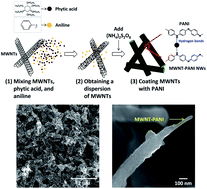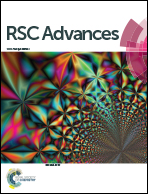Carbon nanotube–polyaniline core–shell nanostructured hydrogel for electrochemical energy storage†
Abstract
Conductive polymer hydrogels, which synergize the advantageous features of hydrogels and conductive materials, have been utilized in many electrochemical energy storage applications. Here, we introduce phytic acid as (1) a dispersing agent for pristine multi-walled carbon nanotubes (MWNTs) in aqueous solution containing aniline and as (2) a gelator to form polyaniline (PANI)-based hydrogels after polymerization. The PANI-based hydrogels exhibit nanowire-based mesoporous networks with high surface area and electrical conductivity. The nanostructured core (MWNT)–shell (PANI) hydrogels show an improvement on the electrical conductivity from 0.21 to 1.54 S cm−1 as the loading of MWNTs increases from 0 to 5.0 wt%. The conducting nanowire-based networks with MWNT loadings of 3.0 wt% in the hydrogel provide efficient electron transport pathways that exhibit a maximal specific capacity of 609 F g−1. The scalable and facile synthesis demonstrates excellent electrochemical performance, rendering it attractive for sensing, energy conversion, and energy storage applications.

- This article is part of the themed collection: Polymers for Electrochemical Energy Storage

 Please wait while we load your content...
Please wait while we load your content...